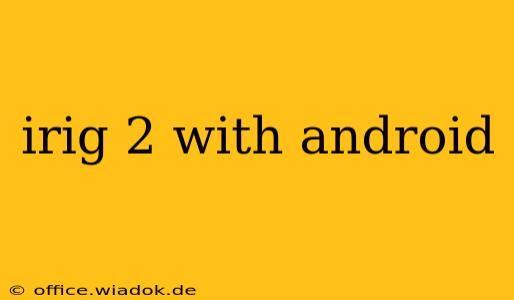The iRig 2 is a popular choice for musicians looking to connect their guitars or basses to their mobile devices. But how well does it work with Android? This comprehensive guide delves into the compatibility, setup, and best practices for using the iRig 2 with your Android smartphone or tablet. We'll explore its capabilities, limitations, and answer frequently asked questions to provide you with a complete understanding of this powerful mobile audio interface.
iRig 2 and Android Compatibility: What You Need to Know
The iRig 2 boasts broad compatibility, working with a wide range of Android devices. However, success hinges on several factors:
-
Android Version: While generally compatible with most modern Android versions, older operating systems might experience limitations or require specific app adjustments. It's crucial to check the manufacturer's website for the most up-to-date compatibility information.
-
Device Power: The iRig 2 is a passive device, meaning it doesn't require an external power source. However, some Android devices might have insufficient power to deliver a strong signal, leading to low volume or noise. Testing is essential.
-
App Compatibility: The true power of the iRig 2 unlocks when used with compatible music apps. Ensure your chosen recording or amp simulation app supports the iRig 2. Popular options include AmpliTube, GarageBand (for Android tablets), and many others. Always verify app compatibility before purchasing.
Setting Up Your iRig 2 with Android: A Step-by-Step Guide
Setting up the iRig 2 is relatively straightforward:
-
Connect the iRig 2: Plug your instrument (guitar or bass) into the iRig 2's input jack.
-
Connect to Android: Use the included USB cable to connect the iRig 2 to your Android device's USB-C or USB-A port (depending on your device).
-
Launch Your App: Open your chosen music app that supports the iRig 2. The app should automatically detect the interface.
-
Audio Settings: Within the music app, navigate to the audio settings and select the iRig 2 as the input source. This step ensures the app receives audio from your instrument through the interface.
-
Testing: Play your instrument. You should hear the sound through your Android device's speakers or headphones. Adjust the input gain on your device or app as needed to achieve the desired volume.
Troubleshooting Common Issues: Solving Your iRig 2 Problems
Despite its ease of use, you might encounter a few hiccups:
-
No Sound: Ensure the iRig 2 is correctly connected to both your instrument and Android device. Check the app settings to confirm that the iRig 2 is selected as the audio input. Verify that the volume on your device and within the app is turned up.
-
Low Volume/Weak Signal: This can be caused by insufficient power from your Android device. Try using a powered USB hub for better results.
-
Noise/Hiss: Try adjusting the input gain. Excessive gain can introduce noise. Using a noise gate within your music app can also help minimize unwanted background noise.
-
App Compatibility Issues: If the app doesn't recognize the iRig 2, try checking for updates for both the app and the device's operating system. Refer to the app's support documentation or the iRig 2's manufacturer website for troubleshooting tips.
Maximizing Your iRig 2 Experience with Android: Tips and Tricks
-
Experiment with Apps: Explore different music apps to find ones that best suit your style and needs. Many offer free trials, enabling you to test before committing.
-
Use Headphones: Using headphones provides a more private and controlled listening experience while minimizing background noise.
-
Power Management: To avoid unexpected power interruptions, make sure your Android device is adequately charged. Consider using a battery pack for extended use.
-
Regular Maintenance: Keep the iRig 2's connectors clean and free of dust and debris to maintain optimal audio quality and connection reliability.
The iRig 2 provides a versatile and accessible way to connect your guitar or bass to your Android device. By understanding its capabilities and addressing potential challenges, you can unlock the full potential of this compact and powerful mobile audio interface, creating music anytime, anywhere.

